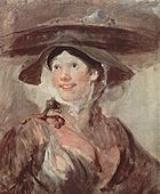
The Shrimp Girl
Encyclopedia
The Shrimp Girl is a painting by the English
artist William Hogarth
. It was painted around 1740–45, and is held by the National Gallery, London.
The painting, a relatively late work by Hogarth, is one of several in which he experimented with a loose, almost impressionistic
style comparable to the work of Fragonard
. In its subject matter, it resembles the prints of hawkers and traders popular in Hogarth's day.
The painting depicts a woman selling shellfish on the streets of London, typically a job for the wives and daughters of fishmongers who owned stalls in markets such as Billingsgate
. The subject balances a large basket on her head, bearing shrimps and mussels, together with a half-pint pewter pot as a measure. Its size suggests that it was intended as a portrait, rather than a sketch for a larger work.
It is not strictly finished and was still in Hogarth's estate after his death. His widow Jane was said to have told visitors on showing the picture to them: "They say he could not paint flesh. There is flesh and blood for you." It was only sold after his wife's death in 1789, and first received its title The Shrimp Girl in a Christie's
sale catalogue.
The painting (retitled The Saleswoman of Crabs) was used on a postage stamp
by the Yemen Arab Republic
in 1969.
England
England is a country that is part of the United Kingdom. It shares land borders with Scotland to the north and Wales to the west; the Irish Sea is to the north west, the Celtic Sea to the south west, with the North Sea to the east and the English Channel to the south separating it from continental...
artist William Hogarth
William Hogarth
William Hogarth was an English painter, printmaker, pictorial satirist, social critic and editorial cartoonist who has been credited with pioneering western sequential art. His work ranged from realistic portraiture to comic strip-like series of pictures called "modern moral subjects"...
. It was painted around 1740–45, and is held by the National Gallery, London.
The painting, a relatively late work by Hogarth, is one of several in which he experimented with a loose, almost impressionistic
Impressionism
Impressionism was a 19th-century art movement that originated with a group of Paris-based artists whose independent exhibitions brought them to prominence during the 1870s and 1880s...
style comparable to the work of Fragonard
Jean-Honoré Fragonard
Jean-Honoré Fragonard was a French painter and printmaker whose late Rococo manner was distinguished by remarkable facility, exuberance, and hedonism. One of the most prolific artists active in the last decades of the Ancien Régime, Fragonard produced more than 550 paintings , of which only five...
. In its subject matter, it resembles the prints of hawkers and traders popular in Hogarth's day.
The painting depicts a woman selling shellfish on the streets of London, typically a job for the wives and daughters of fishmongers who owned stalls in markets such as Billingsgate
Billingsgate
Billingsgate is a small ward in the south-east of the City of London, lying on the north bank of the River Thames between London Bridge and Tower Bridge...
. The subject balances a large basket on her head, bearing shrimps and mussels, together with a half-pint pewter pot as a measure. Its size suggests that it was intended as a portrait, rather than a sketch for a larger work.
It is not strictly finished and was still in Hogarth's estate after his death. His widow Jane was said to have told visitors on showing the picture to them: "They say he could not paint flesh. There is flesh and blood for you." It was only sold after his wife's death in 1789, and first received its title The Shrimp Girl in a Christie's
Christie's
Christie's is an art business and a fine arts auction house.- History :The official company literature states that founder James Christie conducted the first sale in London, England, on 5 December 1766, and the earliest auction catalogue the company retains is from December 1766...
sale catalogue.
The painting (retitled The Saleswoman of Crabs) was used on a postage stamp
Postage stamp
A postage stamp is a small piece of paper that is purchased and displayed on an item of mail as evidence of payment of postage. Typically, stamps are made from special paper, with a national designation and denomination on the face, and a gum adhesive on the reverse side...
by the Yemen Arab Republic
Yemen Arab Republic
The Yemen Arab Republic , also known as North Yemen or Yemen , was a country from 1962 to 1990 in the western part of what is now Yemen...
in 1969.

